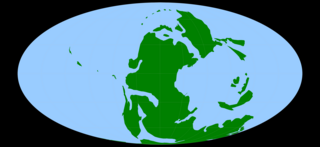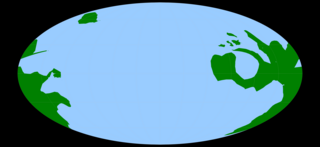Fossil Record is a biannual peer-reviewed scientific journal covering palaeontology. It was established in 1998 as the Mitteilungen aus dem Museum für Naturkunde in Berlin, Geowissenschaftliche Reihe and originally published on behalf of the Museum für Naturkunde by Wiley-VCH. On 1 January 2022, Fossil Record changed publisher to Pensoft Publishers, the editor-in-chief is Florian Witzmann.

Paleontology, also spelled palaeontology or palæontology, is the scientific study of life that existed prior to the start of the Holocene epoch. It includes the study of fossils to classify organisms and study their interactions with each other and their environments. Paleontological observations have been documented as far back as the 5th century BC. The science became established in the 18th century as a result of Georges Cuvier's work on comparative anatomy, and developed rapidly in the 19th century. The term has been used since 1822 formed from Greek παλαιός, ὄν, and λόγος.

The Permian is a geologic period and stratigraphic system which spans 47 million years from the end of the Carboniferous Period 298.9 million years ago (Mya), to the beginning of the Triassic Period 251.902 Mya. It is the last period of the Paleozoic Era; the following Triassic Period belongs to the Mesozoic Era. The concept of the Permian was introduced in 1841 by geologist Sir Roderick Murchison, who named it after the region of Perm in Russia.

Elsevier is a Dutch academic publishing company specializing in scientific, technical, and medical content. Its products include journals such as The Lancet, Cell, the ScienceDirect collection of electronic journals, Trends, the Current Opinion series, the online citation database Scopus, the SciVal tool for measuring research performance, the ClinicalKey search engine for clinicians, and the ClinicalPath evidence-based cancer care service. Elsevier's products and services include digital tools for data management, instruction, research analytics, and assessment. Elsevier is part of the RELX Group, known until 2015 as Reed Elsevier, a publicly-traded company. According to RELX reports, in 2022 Elsevier published more than 600,000 articles annually in over 2,800 journals; as of 2018 its archives contained over 17 million documents and 40,000 e-books, with over one billion annual downloads.

The Tonian is the first geologic period of the Neoproterozoic Era. It lasted from 1000 to 720 Mya. Instead of being based on stratigraphy, these dates are defined by the ICS based on radiometric chronometry. The Tonian is preceded by the Stenian Period of the Mesoproterozoic Era and followed by the Cryogenian.
Simon Conway Morris is an English palaeontologist, evolutionary biologist, and astrobiologist known for his study of the fossils of the Burgess Shale and the Cambrian explosion. The results of these discoveries were celebrated in Stephen Jay Gould's 1989 book Wonderful Life. Conway Morris's own book on the subject, The Crucible of Creation (1998), however, is critical of Gould's presentation and interpretation.
Robert "Bob" Lynn Carroll was an American–Canadian vertebrate paleontologist who specialised in Paleozoic and Mesozoic amphibians and reptiles.
The Furongian is the fourth and final epoch and series of the Cambrian. It lasted from 497 to 485.4 million years ago. It succeeds the Miaolingian series of the Cambrian and precedes the Lower Ordovician Tremadocian Stage. It is subdivided into three stages: the Paibian, Jiangshanian and the unnamed 10th stage of the Cambrian.

Michael James Benton is a British palaeontologist, and professor of vertebrate palaeontology in the School of Earth Sciences at the University of Bristol. His published work has mostly concentrated on the evolution of Triassic reptiles but he has also worked on extinction events and faunal changes in the fossil record.

Stephen Louis Brusatte FRSE is an American paleontologist and evolutionary biologist who specializes in the anatomy and evolution of dinosaurs. He was educated at the University of Chicago for his Bachelor's degree, at the University of Bristol for his Master's of Science on a Marshall Scholarship, and finally at the Columbia University for Master's in Philosophy and Doctorate. He is currently Professor of Palaeontology and Evolution at the University of Edinburgh. In April 2024, Brusatte was elected to fellowship of the Royal Society of Edinburgh.
Geobios is an academic journal published bimonthly by the publishing house Elsevier. Geobios is an international journal of paleontology, focusing on the areas of palaeobiology, palaeoecology, palaeobiogeography, stratigraphy and biogeochemistry.

Philip Conrad James Donoghue FRS is a British palaeontologist and Professor of Palaeobiology at the University of Bristol.

Current Biology is a biweekly peer-reviewed scientific journal that covers all areas of biology, especially molecular biology, cell biology, genetics, neurobiology, ecology, and evolutionary biology. The journal includes research articles, various types of review articles, as well as an editorial magazine section. The journal was established in 1991 by the Current Science group, acquired by Elsevier in 1998 and has since 2001 been part of Cell Press, a subdivision of Elsevier. According to Journal Citation Reports, the journal has a 2020 impact factor of 10.834. It was categorized as a "high impact journal" by the Superfund Research Program.
BMC Ecology and Evolution, previously BMC Evolutionary Biology (2001–2020), is a peer-reviewed open access scientific journal covering all fields of evolutionary biology, including phylogenetics and palaeontology. It was established in 2001 and is part of a series of BMC journals published by BioMed Central.

The Journal of Zoological Systematics and Evolutionary Research is a peer-reviewed scientific journal published by Wiley-VCH in collaboration with Hindawi. It covers the systematic study of animal sciences, connected with evolutionary research. The journal was established in 1963 as the Zeitschrift für zoologische Systematik und Evolutionsforschung and published by Akademische Verlagsgesellschaft. It obtained its current title in 1994 when it was moved to Wiley-VCH.
Stage 2 of the Cambrian is the unnamed upper stage of the Terreneuvian Series. It lies atop the Fortunian and below Stage 3 of the Cambrian. It is commonly referred to as the Tommotian, after the Cambrian stratigraphy of Siberia. Neither the upper nor lower boundary has yet been defined by the International Commission on Stratigraphy. The preferred definitions for the lower boundary are the first appearance of the molluscs Watsonella crosbyi or Aldanella attleborensis around 529 million years ago. The correlation between the lowest occurrences of A. attleborensis and W. crosbyi with the Zhujiaqing positive carbon isotope excursion (ZHUCE) has led to the conclusion that the combination of these two markers are a reliable indicator of the boundary between the Fortunian and Stage 2. The proposed upper boundary might be the first appearance of trilobites around 521 million years ago.

Sci-Hub is a shadow library website that provides free access to millions of research papers, regardless of copyright, by bypassing publishers' paywalls in various ways. Unlike Library Genesis, it does not provide access to books. Sci-Hub was founded in Kazakhstan by Alexandra Elbakyan in 2011, in response to the high cost of research papers behind paywalls. The site is extensively used worldwide. In September 2019, the site's operator(s) said that it served approximately 400,000 requests per day. In addition to its intensive use, Sci-Hub stands out among other shadow libraries because of its easy use/reliability and because of the enormous size of its collection; a 2018 study estimated that Sci-Hub provided access to 95% of all scholarly publications with issued DOI numbers, and on 15 July 2022, Sci-Hub reported that its collection comprised 88,343,822 files.

Susannah "Susie" Catherine Rose Maidment is a British palaeontologist at the Natural History Museum, London. She is internationally recognised for her research on ornithischian dinosaur evolution, and was awarded the 2016 Hodson Award of the Palaeontological Association and the 2017 Lyell Fund of the Geological Society of London. She was featured as a 2019 National Geographic Women of Impact.
This list 2019 in paleomalacology is a list of new taxa of ammonites and other fossil cephalopods, as well as fossil gastropods, bivalves and other molluscs that are scheduled to be described during the year 2019, as well as other significant discoveries and events related to molluscan paleontology that are scheduled to occur in the year 2019.

The Qingjiang biota are a major discovery of fossilized remains dating from the early Cambrian period approximately 518 million years ago. The remains consist at least 20,000 individual specimens, and were discovered near the Danshui River in the Hubei province of China in 2019. The site is particularly notable due to both the large proportion of new taxa represented, and due to the large amount of soft-body tissue of the ancient specimens that was preserved, likely due to the organisms being rapidly covered in sediment prior to fossilization, that allowed for the detailed preservation of even fragile, soft-bodied creatures such as worms and jellyfish. Shelly fossils found at the site include trilobites, anomalocaridids, lobopods, bradoriids, brachiopods, hyolithids, mollusks, chancelloriids, kinorhynchs, priapulids, and articulated sponge spicules.












